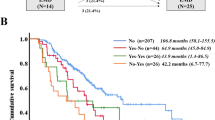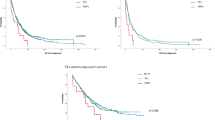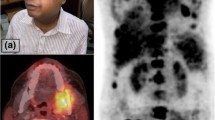Abstract
The prognostic impact of extramedullary plasmacytomas (EMPs) on newly diagnosed symptomatic multiple myeloma (MM) was evaluated in the context of treatment approach including autologous stem cell transplantation (ASCT) and chemotherapy alone. A total of 275 consecutive patients with newly diagnosed MM were included, and 54 patients (19.6 %) had EMPs at diagnosis. Patients with initial EMPs were more likely to have myeloma bone disease but favorable laboratory parameters in hemoglobin and β2-microglobulin. Patients were treated with different schemas based on transplant eligibility (154 in ASCT-eligible vs. 121 in ASCT-ineligible). After a median follow-up of 24.6 months (range, 0.2–56.3 months) in survivors, patients with initial EMPs had significantly worse progression-free survival (PFS) (P = 0.035) and overall survival (OS) (P = 0.006) compared to those without initial EMPs. In the multivariate analyses, the presence of initial EMPs was an independent prognostic factor for PFS (relative risk (RR) of 2.24, P = 0.024) and OS (RR of 2.47, P = 0.027) in the transplant-ineligible patients, whereas it did not significantly influence PFS (P = 0.341) or OS (P = 0.499) in the transplant-eligible patients. However, the adverse impact of EMPs observed in transplant-ineligible patients was attenuated among the patients treated with bortezomib. These data suggest that ASCT can overcome the negative impact of EMPs and highlight the potential efficacy of bortezomib on EMPs in the non-transplant setting.



Similar content being viewed by others
References
Blade J, Fernandez de Larrea C, Rosinol L, Cibeira MT, Jimenez R, Powles R (2011) Soft-tissue plasmacytomas in multiple myeloma: incidence, mechanisms of extramedullary spread, and treatment approach. J Clin Oncol 29:3805–3812
Wu P, Davies FE, Boyd K, Thomas K, Dines S, Saso RM, Potter MN, Ethell ME, Shaw BE, Morgan GJ (2009) The impact of extramedullary disease at presentation on the outcome of myeloma. Leuk Lymphoma 50:230–235
Varettoni M, Corso A, Pica G, Mangiacavalli S, Pascutto C, Lazzarino M (2010) Incidence, presenting features and outcome of extramedullary disease in multiple myeloma: a longitudinal study on 1003 consecutive patients. Ann Oncol 21:325–330
Pour L, Sevcikova S, Greslikova H, Kupska R, Majkova P, Zahradova L, Sandecka V, Adam Z, Krejci M, Kuglik P, Hajek R (2014) Soft-tissue extramedullary multiple myeloma prognosis is significantly worse in comparison to bone-related extramedullary relapse. Haematologica 99:360–364
Laura R, Cibeira MT, Uriburu C, Yantorno S, Salamero O, Blade J, Montserrat E (2006) Bortezomib: an effective agent in extramedullary disease in multiple myeloma. Eur J Haematol 76:405–408
Patriarca F, Prosdocimo S, Tomadini V, Vasciaveo A, Bruno B, Fanin R (2005) Efficacy of bortezomib therapy for extramedullary relapse of myeloma after autologous and non-myeloablative allogeneic transplantation. Haematologica 90:278–279
Lee SE, Yahng SA, Cho BS, Eom KS, Kim YJ, Kim HJ, Lee S, Cho SG, Kim DW, Lee JW, Min WS, Park CW, Min CK (2012) Lymphocyte subset analysis for the assessment of treatment-related complications after autologous stem cell transplantation in multiple myeloma. Cytotherapy 14:505–512
Lee SE, Yoon JH, Shin SH, Cho BS, Eom KS, Kim YJ, Kim HJ, Lee S, Cho SG, Kim DW, Lee JW, Min WS, Park CW, Min CK (2014) Impact of failed response to novel agent induction in autologous stem cell transplantation for multiple myeloma. Ann Hematol 93:627–634
Kyle RA, Rajkumar SV (2009) Criteria for diagnosis, staging, risk stratification and response assessment of multiple myeloma. Leukemia 23:3–9
Durie BG (2006) The role of anatomic and functional staging in myeloma: description of Durie/Salmon plus staging system. Eur J Cancer 42:1539–1543
Usmani SZ, Heuck C, Mitchell A, Szymonifka J, Nair B, Hoering A, Alsayed Y, Waheed S, Haider S, Restrepo A, Van Rhee F, Crowley J, Barlogie B (2012) Extramedullary disease portends poor prognosis in multiple myeloma and is over-represented in high-risk disease even in the era of novel agents. Haematologica 97:1761–1767
Rosinol L, Oriol A, Teruel AI, Hernandez D, Lopez-Jimenez J, de la Rubia J, Granell M, Besalduch J, Palomera L, Gonzalez Y, Etxebeste MA, Diaz-Mediavilla J, Hernandez MT, de Arriba F, Gutierrez NC, Martin-Ramos ML, Cibeira MT, Mateos MV, Martinez J, Alegre A, Lahuerta JJ, San Miguel J, Blade J, Programa para el Estudio y la Terapeutica de las Hemopatias Malignas/Grupo Espanol de Mieloma g (2012) Superiority of bortezomib, thalidomide, and dexamethasone (VTD) as induction pretransplantation therapy in multiple myeloma: a randomized phase 3 PETHEMA/GEM study. Blood 120:1589–1596
Wirk B, Wingard JR, Moreb JS (2013) Extramedullary disease in plasma cell myeloma: the iceberg phenomenon. Bone Marrow Transplant 48:10–18
Li J, Shen KN, Huang WR, Li LH, Chen H, Chen WM, Liu KY, Yu L, Zhou DB (2014) Autologous stem cell transplant can overcome poor prognosis in patients with multiple myeloma with extramedullary plasmacytoma. Leuk Lymphoma. doi:10.3109/10428194.2013.853296
Kumar SK, Rajkumar SV, Dispenzieri A, Lacy MQ, Hayman SR, Buadi FK, Zeldenrust SR, Dingli D, Russell SJ, Lust JA, Greipp PR, Kyle RA, Gertz MA (2008) Improved survival in multiple myeloma and the impact of novel therapies. Blood 111:2516–2520
Katodritou E, Gastari V, Verrou E, Hadjiaggelidou C, Varthaliti M, Georgiadou S, Laschos K, Xirou P, Yiannaki E, Constantinou N, Markala D, Zervas K (2009) Extramedullary (EMP) relapse in unusual locations in multiple myeloma: is there an association with precedent thalidomide administration and a correlation of special biological features with treatment and outcome? Leuk Res 33:1137–1140
Avigdor A, Raanani P, Levi I, Hardan I, Ben-Bassat I (2001) Extramedullary progression despite a good response in the bone marrow in patients treated with thalidomide for multiple myeloma. Leuk Lymphoma 42:683–687
Myers B, Grimley C, Crouch D, Dolan G (2001) Lack of response to thalidomide in plasmacytomas. Br J Haematol 115:234
Zeng Z, Zheng L, Lin J, Chen J (2012) Successful bortezomib treatment in combination with dexamethasone and thalidomide for previously untreated epidural plasmacytoma. Oncol Lett 3:557–559
Paubelle E, Coppo P, Garderet L, Azizi L, Bories D, Gorin NC, Fouillard L (2005) Complete remission with bortezomib on plasmocytomas in an end-stage patient with refractory multiple myeloma who failed all other therapies including hematopoietic stem cell transplantation: possible enhancement of graft-vs-tumor effect. Leukemia 19:1702–1704
Billecke L, Murga Penas EM, May AM, Engelhardt M, Nagler A, Leiba M, Schiby G, Kroger N, Zustin J, Marx A, Matschke J, Tiemann M, Goekkurt E, Heidtmann HH, Vettorazzi E, Dierlamm J, Bokemeyer C, Schilling G (2013) Cytogenetics of extramedullary manifestations in multiple myeloma. Br J Haematol 161:87–94
Nieuwenhuizen L, Biesma DH (2008) Central nervous system myelomatosis: review of the literature. Eur J Haematol 80:1–9
Acknowledgments
The authors acknowledge all members at the Catholic Blood and Marrow Transplantation Center, particularly the house staff, for their excellent care of the patients. This study was supported by the Korea Healthcare Technology R&D Project, Ministry of Health& Welfare, Republic of Korea (A120175).
Conflict of interest
The authors declare that they have no conflicts of interest.
Author information
Authors and Affiliations
Corresponding author
Electronic supplementary material
Below is the link to the electronic supplementary material.
Supplementary Fig. 1
Treatment schedule (GIF 324 kb)
Supplementary Fig. 2
Influence of EMPs at diagnosis on survival outcome in transplant-ineligible patients treated with bortezomib-based regimens. a Probabilities of overall survival and b probabilities of progression-free survival (GIF 295 kb)
Rights and permissions
About this article
Cite this article
Lee, SE., Kim, JH., Jeon, YW. et al. Impact of extramedullary plasmacytomas on outcomes according to treatment approach in newly diagnosed symptomatic multiple myeloma. Ann Hematol 94, 445–452 (2015). https://doi.org/10.1007/s00277-014-2216-8
Received:
Accepted:
Published:
Issue Date:
DOI: https://doi.org/10.1007/s00277-014-2216-8




